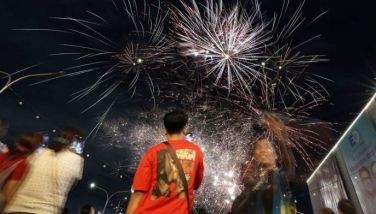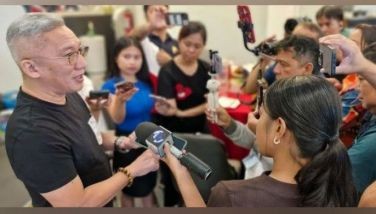LGUs cannot alter PUJ routes given by LTFRB
October 23, 2006 | 12:00am
Local government units have no authority to alter or chage the travel routes that the Land Transportation Franchising and Regulatory Board (LTFRB) has granted to public utility vehicles.
This is contained in a memorandum circular issued by the Department of Interior and Local Government four years ago, which militant drivers hope would allow them to ply their old routes within Cebu City.
The DILG memorandum circular 2002-173 issued by then Secretary Jose Lina on October 18, 2002 supports the legal opinion of the LTFRB-Manila that local government units, such as Cebu City, cannot prevent the passenger jeepneys from Mandaue City to ply the streets of Cebu City.
In a memorandum addressed to all provincial governors, city and municipal mayors, barangay captains and members of the provincial board and city councils, it reads:
"In line with the regulatory power of the LTFRB over public utility vehicles, the determination of the routes to be traversed by the latter are vested in the LTFRB. While concededly LGU's have the power to enact regulatory ordinances, said ordinances, however, cannot contravene national laws."
A copy of Lina's memorandum circular was furnished to the Cebu City Council by Antonio Pogado, chairman of the Nagkahiusang Drayber sa Sugbo (Nadsu), who announced that his members would be back plying to their old routes - General Maxilom Avenue, Fuente Osmeña then to Osmeña Boulevard.
"Sa umaabot nga mga adlaw, karong buwana, mobalik na ang mga 21-B ug 22-B (nga mga PUJ's) sa ilang naandang pagbiyahe. Anaa kanamo ang tanang legal nga basihanan ug sukaranan alang sa padayong pagpamasahero sa among rota," Pogado said in his two-page position paper.
But while the Mandaue-bound PUJ's are insisting to ply the Cebu City streets, the traffic enforcers are also ready to apprehend them and to impound their vehicles.
Many PUJs are still being impounded by the City Traffic Operations Management (CITOM) after its owners failed to pay their huge pending fines, ranging from P100,000 to P300,000 for each of the unit.
"Gisumada man god nila ang wala namo kabayri nga multa sukad pa kaniadtong 2002. Sa usa namo ka pagbiyahe, usahay madakpan mi og kaduha mao nga dagko kaayo ang among multahan," one of the PUJ operators told The Freeman.
In last Wednesday's regular session of the City Council, about 40 operators of Mandaue-bound PUJs sought the help of the city officials to assist them for the release of their units, but Mayor Tomas Osmeña quickly rejected their request.
Osmeña said he could not give a Christmas gift to these PUJ operators who he described as "mga gahi'g ulo" because they insisted on plying the city streets violating the city ordinance 1837.
The officials of the CITOM claimed that the court already settled the legality of City Ordinance 1837 that bans public utility vehicles that are plying the areas outside Cebu City, from entering the city streets.
The ordinance provides that the PUVs plying the various routes outside the city are allowed only to drop and to pick up passengers at any City Hall-accredited terminals.
But Pogado insisted that City Ordinance 1837, as amended by City Ordinance 2072, is "unconstitutional, illegal, ultra vires, vague and over-board as it contradicts with the franchise issued to by the LTFRB."
City Ordinance 2072, amending City Ordinance 1837, was enacted by the city council to allow the traffic enforcers to impound those PUVs coming from the routes outside the city that will be caught for the third time. These would be released only after its operators have settled their pending fines.
Arnel Tancinco, CITOM's executive officer, claimed that the city government -through the CITOM - has the power to regulate the public utility vehicles that would enter the city streets as provided for by the Cebu City charter.
Of all vehicles plying the routes outside Cebu City, only the drivers of Mandaue PUJs insisted to ply the city streets passing General Maxilom Ave., Osmeña Blvd. and back to Mandaue City.
This is contained in a memorandum circular issued by the Department of Interior and Local Government four years ago, which militant drivers hope would allow them to ply their old routes within Cebu City.
The DILG memorandum circular 2002-173 issued by then Secretary Jose Lina on October 18, 2002 supports the legal opinion of the LTFRB-Manila that local government units, such as Cebu City, cannot prevent the passenger jeepneys from Mandaue City to ply the streets of Cebu City.
In a memorandum addressed to all provincial governors, city and municipal mayors, barangay captains and members of the provincial board and city councils, it reads:
"In line with the regulatory power of the LTFRB over public utility vehicles, the determination of the routes to be traversed by the latter are vested in the LTFRB. While concededly LGU's have the power to enact regulatory ordinances, said ordinances, however, cannot contravene national laws."
A copy of Lina's memorandum circular was furnished to the Cebu City Council by Antonio Pogado, chairman of the Nagkahiusang Drayber sa Sugbo (Nadsu), who announced that his members would be back plying to their old routes - General Maxilom Avenue, Fuente Osmeña then to Osmeña Boulevard.
"Sa umaabot nga mga adlaw, karong buwana, mobalik na ang mga 21-B ug 22-B (nga mga PUJ's) sa ilang naandang pagbiyahe. Anaa kanamo ang tanang legal nga basihanan ug sukaranan alang sa padayong pagpamasahero sa among rota," Pogado said in his two-page position paper.
But while the Mandaue-bound PUJ's are insisting to ply the Cebu City streets, the traffic enforcers are also ready to apprehend them and to impound their vehicles.
Many PUJs are still being impounded by the City Traffic Operations Management (CITOM) after its owners failed to pay their huge pending fines, ranging from P100,000 to P300,000 for each of the unit.
"Gisumada man god nila ang wala namo kabayri nga multa sukad pa kaniadtong 2002. Sa usa namo ka pagbiyahe, usahay madakpan mi og kaduha mao nga dagko kaayo ang among multahan," one of the PUJ operators told The Freeman.
In last Wednesday's regular session of the City Council, about 40 operators of Mandaue-bound PUJs sought the help of the city officials to assist them for the release of their units, but Mayor Tomas Osmeña quickly rejected their request.
Osmeña said he could not give a Christmas gift to these PUJ operators who he described as "mga gahi'g ulo" because they insisted on plying the city streets violating the city ordinance 1837.
The officials of the CITOM claimed that the court already settled the legality of City Ordinance 1837 that bans public utility vehicles that are plying the areas outside Cebu City, from entering the city streets.
The ordinance provides that the PUVs plying the various routes outside the city are allowed only to drop and to pick up passengers at any City Hall-accredited terminals.
But Pogado insisted that City Ordinance 1837, as amended by City Ordinance 2072, is "unconstitutional, illegal, ultra vires, vague and over-board as it contradicts with the franchise issued to by the LTFRB."
City Ordinance 2072, amending City Ordinance 1837, was enacted by the city council to allow the traffic enforcers to impound those PUVs coming from the routes outside the city that will be caught for the third time. These would be released only after its operators have settled their pending fines.
Arnel Tancinco, CITOM's executive officer, claimed that the city government -through the CITOM - has the power to regulate the public utility vehicles that would enter the city streets as provided for by the Cebu City charter.
Of all vehicles plying the routes outside Cebu City, only the drivers of Mandaue PUJs insisted to ply the city streets passing General Maxilom Ave., Osmeña Blvd. and back to Mandaue City.
BrandSpace Articles
<
>
- Latest
- Trending
Trending
Latest





















